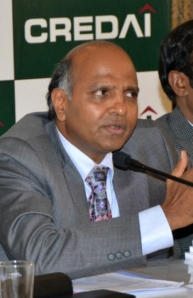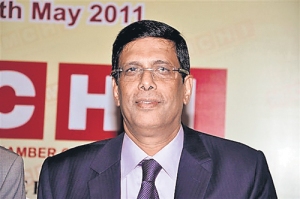STATUS QUO
The realty sector voices its displeasure on the Reserve Bank of India’s recent decision to keep the key policy rates unchanged once again

LALIT KUMAR JAIN, NATIONAL PRESIDENT,CREDAI
The cost of funding of Real Estate is very high and home buyers as well as developers expected the RBI to come out with a positive policy and facilitate drastic reduction in interest rate. We have been pointing out that the real estate industry is not only the second largest employer in the country but also contributes handsomely to the GDP and growth of 400 other industries. After the recent meeting with the Finance Ministry officials, CREDAI was hopeful that the government and the RBI would come out with a pragmatic policy. However, we are thoroughly disappointed with this stingy approach of the RBI. We have given a representation to the RBI and we wish they consider it seriously.

PARAS GUNDECHA, PRESIDENT, MCHI-CREDA I
MCHI-CREDAI, the voice of the developer community, strongly advocates further reduction rate cuts to bring down the cost of funding of homes. The government and the central bank should facilitate lower interest rates. Many home seekers have been waiting on the fence and the RBI must help improve the market sentiment. The cost of inputs is very high and hence the RBI should help bring down the interest rates.

MANJU YAGNIK,
VICE – CHAIRPERSON, NAHAR GROUP
The recent wave of reforms had turned the market sentiments for the better and to a great extent pushed up hopes of a rate-cut which would have boosted real estate (housing sector pre-dominantly). Rising raw material costs, lack of single window clearance and an industry status which would have made it possible for developers to acquire finance at lower rates are factors which have added to the sluggishness in the sector. If one carefully analyses the market, it’s apparent that there’s a dire need but low demand due to high loan interest rates.
Rate cut was a ray of hope, and with just 25 basis points this was quite disappointing. This has been voiced out clearly by industry representative bodies like MCHI and CREDAI. While I understand that the government is restricted by the pressure of inflation, I feel there is a dire need for it to take a bold step if something as basic as a home has to be brought within the reach of a common man.”
DR. SAMANTAK DAS
DIRECTOR- RESEARCH AND ADVISORY SERVICES, KNIGHT FRANK INDIA
While initiating action is the prerogative of the government, expectation from the central bank is also high to help in arresting the faltering economic growth. Not withstanding high expectation to reduce interest rates, the RBI has kept the key repo and reverse rate unchanged in its second quarter (July-September) monetary policy review. Only the Cash Reserve Ratio (CRR) has been cut by 25 bps in a bid to increase liquidity in the system. This move however, is not expected to yield much respite because anyways the credit growth has been mute and the biggest concern is the high cost of capital. Thus, reducing repo would have helped corporate and households alike.The actions of the central bank are more on account of the high inflationary expectations than anything else, implying that rejuvenating growth will remain the second priority of the bank.

ANSHUMAN MAGAZINE, CHAIRMAN AND MD, CBRE SOUTH ASIA PVT. LTD
The RBI’s decision to keep the key policy rates unchanged once again is a disappointment for the realty sector. While a cut of 25 base points in the CRR Rate does infuse some liquidity, a reduction in the repo rate would have helped boost investor sentiment. The festive season coupled with an expected change in policy rates would have been ideals for improving consumer confidence.

SANJAY DUTT, EXECUTIVE MANAGING DIRECTOR, SOUTH ASIA, CUSHMAN & WAKEFIELD
Given the stressed liquidity scenario in the economy, RBI has announced a cut in Cash Reserve Ratio (CRR) by 25 basis point from 4.5% to 4.25%. This step by RBI is expected to infuse INR 175 billion into our banking system, which is expected to have a positive impact on the realty sector, as some part of it will flow into the industry, which is already facing a liquidity crunch. The primary objective of this policy is to focus on taming inflation and hence the interest rates remained unchanged. An action on rate cuts would have been encouraging for the industry, as it would have provided a positive boost to market sentiments and resulted in increased transaction activities in the residential sales markets, which have been slow for some time.

SIMON RUBINSOHN, CHIEF ECONOMIST, RICS
The decision of the RBI to leave on hold the repo rate at its latest policy meeting was not entirely unexpected given the ongoing concerns surrounding the inflation picture. The rise in the WPI measure to a 10-month high in September of 7.8% coupled with elevated household inflation expectations, which currently stand at 12% for the next year, provided the justification for the cautious stand of the authorities. However, it is significant that the RBI still took the decision to lower the cash reserve ratio by a further quarter point. The importance of this move, although relatively modest, should not be overlooked as it will have a direct bearing on borrowing rates and the capacity of the banking sector to lend. That said, it is unlikely to be sufficient to reverse the course of the economy in the near term. More likely, pressure will build on the authorities to take further action in the early part of 2013 particularly if there are signs of both the inflation dynamic improving and the recent plan outlined by the Finance Minister Chidambaram to address the country’s large budget deficit is a runner.
As far as the real estate is concerned, this move should offer some support for the residential sector and underpin the improving trend in both launches and sales visible in the third quarter; they are now showing a positive year-on-year trend after a sticky couple of years. Our suspicion is, however, that the commercial market will remain broadly flat over the coming months.

ANSHUL JAIN, CEO, DTZ INDIA
Given that the government has not been able to reign in the fiscal deficit which had risen to 5.8% of GDP at the end of FY 2011-12, the RBI remained conservative during the Second Quarter Review of Monetary Policy for 2012-13. Maintaining its anti-inflation stance, the Central bank left the key policy rates unchanged. As a trade-off, a cut in the CRR by 25bps has been announced. The CRR cut will infuse Rs 17,500 crore into the banking system. However, with the policy rates unchanged, the additional liquidity will have marginal impact. In the past, we have seen that a cut in the CRR has resulted in PSU banks lowering their lending rates anywhere between 0.25% and 0.5% depending on the type of loan (home loan, car loan etc.). From real estate perspective, the potential home loan seekers have been eagerly waiting for lowering of the policy rates to go ahead with the purchase of their dream home. But the high interest rates have been quite discouraging. A reduction in the policy rates is urgently required to boost the market sentiment and make any visible impact on the demand.
In order to revive the sluggish domestic economy, the central government has unveiled a slew of policy reforms along with a five-year fiscal consolidation plan that aims to almost halve the deficit by 2017 and cut it to 5.3% of the GDP in the current financial year. The key to achieving the objective of these announcements lies in their successful implementation. As soon as the impact of these reforms start appearing, hopefully by third quarter of the current financial year, we expect RBI to cut the key policy rates by 25-50 bps.
Tagged: Builders, CREDAI, Developers, Flat buyers, Home Loan, Infrastructure, investment, MCHI, Mumbai property, mumbaipropertyexchange, nahar group, property investment, RBI, Real Estate News


Leave a comment